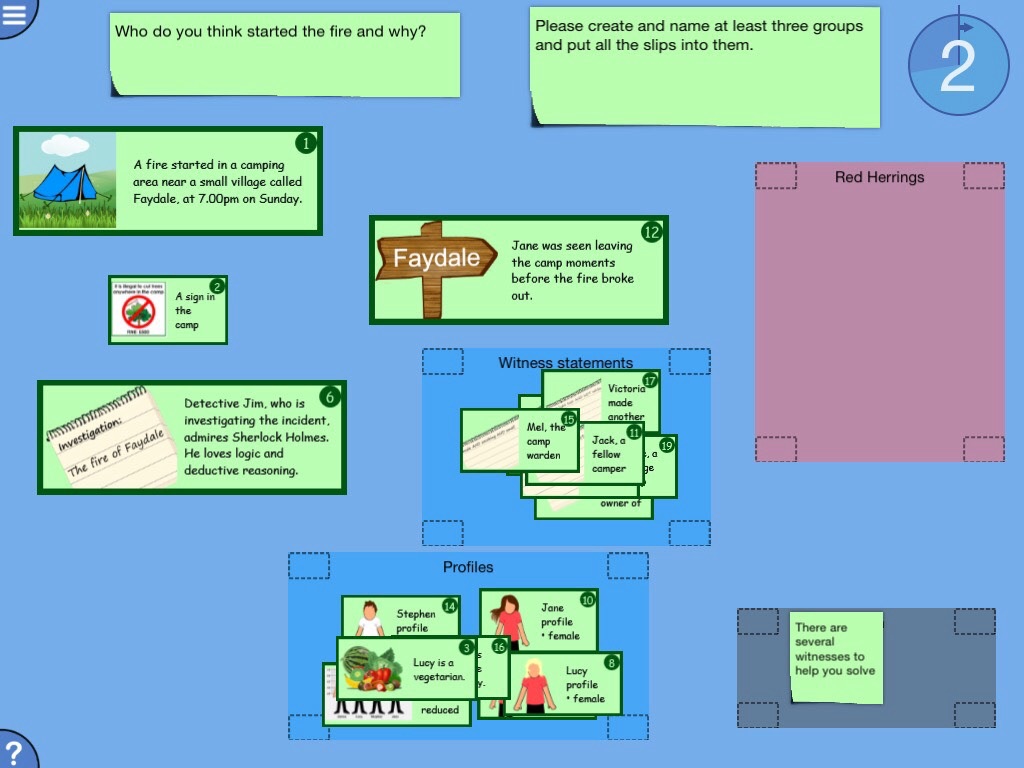
Fire of Faydale (Computing) app for iPhone and iPad
Developer: Reflective Thinking
First release : 19 Mar 2015
App size: 31.62 Mb
This is a unique app in allowing pairs to work simultaneously on one iPad with a task designed to help students understand Boolean logic (KS3 computing curriculum).
It is a ‘whodunit’ style mystery about Detective Jim who uses ‘AND’, ‘OR’ and ‘NOT’ Boolean logic operators to help him solve crimes. Students are given illustrated slips of information on the case hes currently working on and asked ‘Who do you think started the fire and why?’ They must read these, sort them into groups and then lay them out on screen to show how they came to their answer.
The task can be used to discuss the use of simple logical operators or as an assessment tool for students’ understanding of how to apply such logic. Users play the role of the detective by reading witness statements to narrow down suspects from lots of information (just as they would use these operators to narrow down search results from a very large set of input data). Although theres no one right answer, if students combine the clues and apply simple Boolean logic, they can work out who mightve been involved in different activities the night of the Faydale fire and make their own arguments.
Afterwards, students can generate a PDF report of the session which can be shared or printed, plus they can move to a Reflection Stage. This involves sitting as a group, with their teacher, or as a whole class, and playing back the app session to help them reflect on what they’ve understood, discussed or learned. While students do this, it will also help develop their problem-solving, communication and collaboration skills.
Who is this app for?
This app works well with those aged 11-14 (KS3). By having 3 difficulty levels, it supports differentiation in class and can be suited to varying abilities/levels of knowledge.
On easy, there are 16 slips; 1 witness statement for each activity (e.g. having a BBQ) is provided.
On medium, an extra 3 statements are added; 1 for each activity. These don’t actually add new information but give a different logical presentation, e.g. ‘not light hair AND not tall’ is the same as ‘dark hair AND small’. This helps students understand how the same statement can be represented differently with the ‘NOT’ operator.
On hard, 2 more witnesses are added as well as the purchasing of matches. This adds complexity to the story.
Only by considering all the information and applying the logic provided, can students form a theory as to what happened.
What is different about Digital Mysteries?
• Truly collaborative: It is unique in that more than one student can interact with it at once
• Curriculum-mapped: Tasks are directly mapped to the National Curriculum for England
• Retention: Working with information slips from two different perspectives (grouping, then fitting them into a sequence) ensures students remember more
• Higher-level thinking: The multiple discussion points, combined with the task’s open-ended nature, leads to students developing these skills
• Record of learning: Students can interact and have fun with exciting technology then generate a printable PDF report of their session which shows what they’ve done
What does a mystery consist of?
• Illustrated slips of information: Including facts on the topic alongside story-based snippets about a particular character and their experiences
• Open question: To maximise the potential of collaboration, discussion, and expression of ideas, the nature of the task is usually open ended
• Extras: Most tasks come with personalised hints for those who need them (suggestions for grouping or sequencing their slips)
• Description: This gives teachers the information they need to plan their session including the curriculum point each task links to, the advised age range and possible learning outcomes
How can I try other mysteries?
At the bottom of the app details tab, tap ‘Developer Apps’ to view our current range. Many more are coming soon with subjects including English, Geography and Computing in KS1-4.



